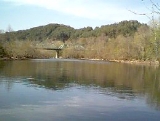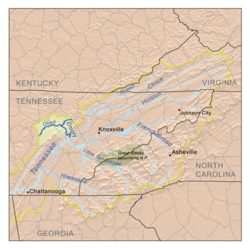
Emory River
Encyclopedia

Stream
A stream is a body of water with a current, confined within a bed and stream banks. Depending on its locale or certain characteristics, a stream may be referred to as a branch, brook, beck, burn, creek, "crick", gill , kill, lick, rill, river, syke, bayou, rivulet, streamage, wash, run or...
draining a portion of Tennessee
Tennessee
Tennessee is a U.S. state located in the Southeastern United States. It has a population of 6,346,105, making it the nation's 17th-largest state by population, and covers , making it the 36th-largest by total land area...
's Cumberland Plateau
Cumberland Plateau
The Cumberland Plateau is the southern part of the Appalachian Plateau. It includes much of eastern Kentucky and western West Virginia, part of Tennessee, and a small portion of northern Alabama and northwest Georgia . The terms "Allegheny Plateau" and the "Cumberland Plateau" both refer to the...
.
Hydrography
The Emory River rises on the slopes of Frozen HeadFrozen Head
Frozen Head is a mountain in Morgan County, Tennessee. It is the second highest peak in the Crab Orchard Mountains, at . Frozen Head is located in Frozen Head State Park and Natural Area....
and Bird Mountain, prominent peaks in that part of the Cumberland Plateau in Morgan County, Tennessee. Frozen Head is the focus of a Tennessee state park
State park
State parks are parks or other protected areas managed at the federated state level within those nations which use "state" as a political subdivision. State parks are typically established by a state to preserve a location on account of its natural beauty, historic interest, or recreational...
and natural area called Frozen Head State Park
Frozen Head State Park
Frozen Head State Park and Natural Area is a state park in Morgan County, Tennessee, in the southeastern United States. The park, situated in the Crab Orchard Mountains between the city of Wartburg and the community of Petros, contains some of the highest mountains in Tennessee west of the Blue...
. The surrounding area has been the subject of extensive strip mining for coal
Coal
Coal is a combustible black or brownish-black sedimentary rock usually occurring in rock strata in layers or veins called coal beds or coal seams. The harder forms, such as anthracite coal, can be regarded as metamorphic rock because of later exposure to elevated temperature and pressure...
which has resulted in some stream pollution
Water pollution
Water pollution is the contamination of water bodies . Water pollution occurs when pollutants are discharged directly or indirectly into water bodies without adequate treatment to remove harmful compounds....
. The stream initially flows basically westward and is crossed by U.S. Highway 27. Turning more southwestward, it is paralleled for a time by a line of the Norfolk Southern Railway
Norfolk Southern Railway
The Norfolk Southern Railway is a Class I railroad in the United States, owned by the Norfolk Southern Corporation. With headquarters in Norfolk, Virginia, the company operates 21,500 route miles in 22 eastern states, the District of Columbia and the province of Ontario, Canada...
. It meets the Obed River
Obed River
Obed River is a stream draining a part of the Cumberland Plateau in Tennessee. It, and particularly its tributaries, are important streams for whitewater enthusiasts....
in the southeast corner of the expansive Catoosa Wildlife Management Area
Catoosa Wildlife Management Area
Catoosa Wildlife Management Area is a large game-management area on the Upper Cumberland Plateau in Morgan and Cumberland counties in Tennessee in the United States. It comprises 82,000 acres of wild land administered by the Tennessee Wildlife Resources Agency...
, a large game-management area operated by the Tennessee Wildlife Resources Agency.
In an unusual departure from the generally accepted convention that the larger stream name is retained downstream of the confluence with a notably smaller one, the stream from this point retains the name "Emory River" even though the Obed at the point of confluence is considerably larger than the Emory. Still paralleled by the railroad, the stream crosses into Roane County near Harriman
Harriman, Tennessee
Harriman is a city in the U.S. state of Tennessee, primarily in Roane County, with a small extension into Morgan County. It is the principal city of and is included in the Harriman Micropolitan Statistical Area, which consists of Roane County and is a component of the Knoxville-Sevierville-La...
. Backwaters of the Watts Bar Lake
Watts Bar Lake
Watts Bar Lake is a reservoir on the Tennessee River created by Watts Bar Dam as part of the Tennessee Valley Authority system.-Geography:Located about midway between Chattanooga and Knoxville, the lake begins as the Tennessee River below Fort Loudon Dam in Lenoir City, Tennessee and stretches...
impoundment of the Tennessee River
Tennessee River
The Tennessee River is the largest tributary of the Ohio River. It is approximately 652 miles long and is located in the southeastern United States in the Tennessee Valley. The river was once popularly known as the Cherokee River, among other names...
cause the water below Harriman to be somewhat slack. The Little Emory River
Little Emory River
The Little Emory River rises in Morgan County, Tennessee near the town of Coalfield. It is one of the major tributaries to the Emory River. It crosses into Roane County, where it soon becomes an embayment of Watts Bar Lake several miles upstream of its mouth into the Emory...
is also impounded somewhat above its mouth into the Emory below Harriman.
The mouth of the Emory is into the Clinch River
Clinch River
The Clinch River rises in Southwest Virginia near Tazewell, Virginia and flows southwest through the Great Appalachian Valley, gathering various tributaries including the Powell River before joining the Tennessee River in East Tennessee.-Course:...
at the Tennessee Valley Authority
Tennessee Valley Authority
The Tennessee Valley Authority is a federally owned corporation in the United States created by congressional charter in May 1933 to provide navigation, flood control, electricity generation, fertilizer manufacturing, and economic development in the Tennessee Valley, a region particularly affected...
's Kingston Power Plant, a coal-fired electric generation station initially developed during World War II
World War II
World War II, or the Second World War , was a global conflict lasting from 1939 to 1945, involving most of the world's nations—including all of the great powers—eventually forming two opposing military alliances: the Allies and the Axis...
, largely to power the uranium
Uranium
Uranium is a silvery-white metallic chemical element in the actinide series of the periodic table, with atomic number 92. It is assigned the chemical symbol U. A uranium atom has 92 protons and 92 electrons, of which 6 are valence electrons...
enrichment plants used to make the world's first atomic bomb at nearby Oak Ridge National Laboratory
Oak Ridge National Laboratory
Oak Ridge National Laboratory is a multiprogram science and technology national laboratory managed for the United States Department of Energy by UT-Battelle. ORNL is the DOE's largest science and energy laboratory. ORNL is located in Oak Ridge, Tennessee, near Knoxville...
. The 2008 Kingston Fossil Plant coal fly ash slurry spill
Kingston Fossil Plant coal fly ash slurry spill
The TVA Kingston Fossil Plant coal fly ash slurry spill occurred just before 1 a.m. on Monday December 22, 2008, when an ash dike ruptured at an solid waste containment area at the Tennessee Valley Authority's Kingston Fossil Plant in Roane County, Tennessee, USA. of coal fly ash slurry was...
heavily polluted the Emory river and surrounding area.
Etymology
According to a 1910 article in the Rockwood Times by Captain William E. McElwee, the river was named after "William Emery", an early traveler who drowned while swimming the river with his "accoutrements" on. Early deed books sometimes refer to this as "William Emeries River". The IndianIndigenous peoples of the Americas
The indigenous peoples of the Americas are the pre-Columbian inhabitants of North and South America, their descendants and other ethnic groups who are identified with those peoples. Indigenous peoples are known in Canada as Aboriginal peoples, and in the United States as Native Americans...
name for the Emory River was "Babahatchie", which means "babbling waters."

